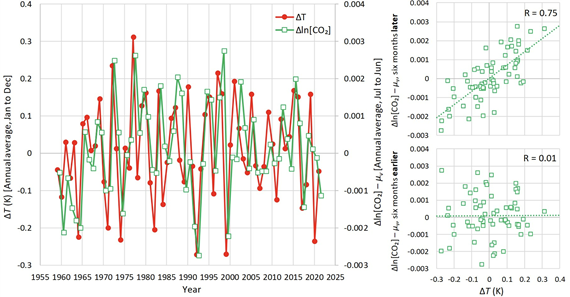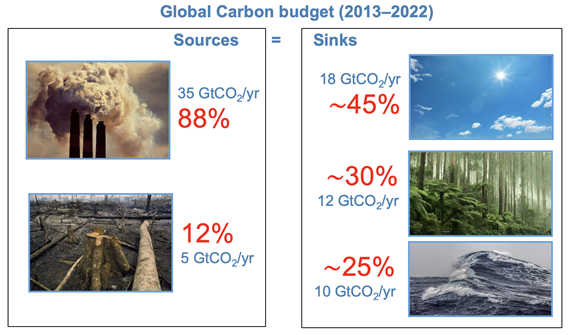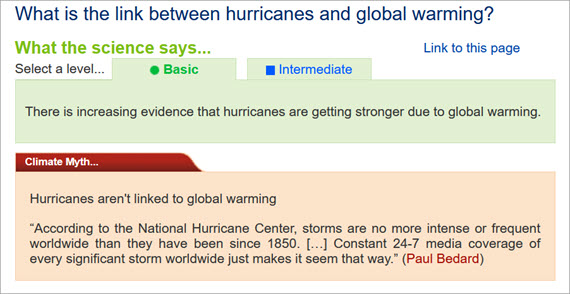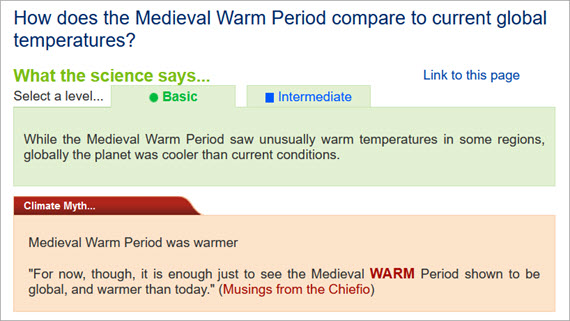To kick off hurricane season, Yale Climate Connections editors Sara Peach and Sam Harrington sat down with meteorologists and Eye on the Storm writers Jeff Masters and Bob Henson.
This roundtable discussion has been edited and condensed.
Sam: What is your process of covering a hurricane?
Jeff: It kind of starts on Twitter or Bluesky now. Some of the aficionados of hurricane forecasting are anticipating, well before the National Hurricane Center puts something out, that “Hey, this is something we got to watch.” And of course, Bob and I look on our own at the models and see just kind of the general pattern, how things are shaping up. It can give you a general feel for something that might be coming up.
Bob: Yeah, I think there’s more and more skill with identifying busy periods. Even if the individual hurricanes aren’t ironclad, the models will give us a sense of maybe a particular week might be busy. So we try to keep an eye out for busy periods.
Jeff: Yeah, I’ll adjust my vacation schedule, depending on what the models are showing. I mean, I like to go up north and go camping near Lake Superior. And I’ll try and come up with a four- or five-day stretch that’s not going to see a major landfalling storm, according to the latest model guidance.
This year, it could be an early hurricane season.
Sam: Is that what it’s feeling like to you?
2024 SkS Weekly Climate Change & Global Warming News Roundup #22
Posted on 2 June 2024 by BaerbelW, Doug Bostrom, John Hartz
Story of the week
Sometimes one story is not enough.
Our ongoing 2023-2024 experiences with lethal heatwaves, early wildfires and a threatening Atlantic hurricane season are reminders that climate progress in public policy and law has been glacially slow, far outpaced by inexorable radiative physics colliding with our CO2 emissions. We're hardly looking at a track record of unalloyed success.
Our list of articles this week gives some clues to why we're facing extreme conditions we could have better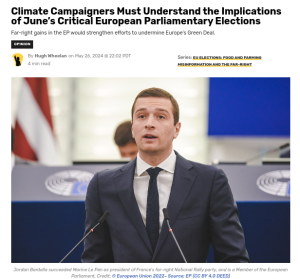 ameliorated, or even avoided. Published by DeSmog, Climate Campaigners Must Understand the Implications of June`s Critical European Parliamentary Elections describes an archetypal competently organized and knife-edged campaign by the fossil fuel industry to undermine productive public policy intended to deal with our climate crisis. This disciplined task force faces a general public that routinely leaves more than half of EU parliamentary election ballots unfilled. It's arguable that the fossil fuel collective's concerted efforts (admirable skills— if aligned to a better purpose) with a healthy dash of public sloth and apathy are why we're now living in a world of extremes.
ameliorated, or even avoided. Published by DeSmog, Climate Campaigners Must Understand the Implications of June`s Critical European Parliamentary Elections describes an archetypal competently organized and knife-edged campaign by the fossil fuel industry to undermine productive public policy intended to deal with our climate crisis. This disciplined task force faces a general public that routinely leaves more than half of EU parliamentary election ballots unfilled. It's arguable that the fossil fuel collective's concerted efforts (admirable skills— if aligned to a better purpose) with a healthy dash of public sloth and apathy are why we're now living in a world of extremes.
Is rational acknowledgement of our predicament a lost cause? It might be better to think of this as a matter of momentum. If so, where can we see that? Another notable story this week happened in Vermont, USA and is covered by The Guardian's Dharma Noor: `Game-changing`: Vermont becomes first state to require big oil to pay for climate damages. Let alone 20 years ago, this legislation would have been hard to imagine in 2014. It's an agonizingly slow and needlessly costly process but Vermont now has evidence of climate change in plain sight. Explanations of that evidence are accepted— and then form the basis of public policy to deal with outcomes.
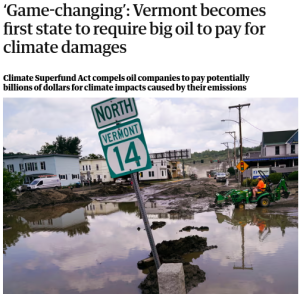 It's worth remembering: about 325 years have passed since Thomas Savery introduced the first coal-fired motive power apparatus to find a home in industry. Since then we've wrapped our entire culture first around coal and then adding liquid and gas hydrocarbons to the mix. 326 years of habit is a lot of momentum. In contrast, serious early warning of the side-effects of our expedient natural gift reached the ears of legislators and public executives some 59 years ago. Six decades is short compared to over three hundred years. What's more, about forty of these years were pretty much completely wasted thanks to such foot-dragging as what's happening in the EU as described above.
It's worth remembering: about 325 years have passed since Thomas Savery introduced the first coal-fired motive power apparatus to find a home in industry. Since then we've wrapped our entire culture first around coal and then adding liquid and gas hydrocarbons to the mix. 326 years of habit is a lot of momentum. In contrast, serious early warning of the side-effects of our expedient natural gift reached the ears of legislators and public executives some 59 years ago. Six decades is short compared to over three hundred years. What's more, about forty of these years were pretty much completely wasted thanks to such foot-dragging as what's happening in the EU as described above.
What we see in these two stories is that dots are being connected. Vermont's legislation will encounter a blizzard of court action but regardless of the exact outcome this furor wouldn't be happening if accountability had not been assigned. It's a watershed moment in the US, part of burgeoning global momentum. All signs are toward accumulation of legal and regulatory energy to deal with climate change— and with that we should expect climate progress to accelerate. As we see in Vermont, this advancement happens by taking a little time to see what happening— and then voting according to one's conclusions.
Stories we promoted this week, by publication date:
Before May 26
- Why the COP28 climate summit mattered, and what to watch for in 2024, The Conversation, Rachel Kyte.
- Republican AGs ask Supreme Court to block climate change lawsuits brought by several states, The Independent News, David A. Lieb. Nineteen Republican state attorneys general have asked the U.S. Supreme Court to get involved in a dispute over climate-change lawsuits
- The hidden crisis in Europe's groundwater, Under the Surface, by Zeynep Sentek, Jelena Prtori?, & Sarah Pilz .
- Skeptical Science New Research for Week #21 2021, Skeptical Science, Doug Bostrom & Marc Kodack. Skeptical Science's own weekly compendium of climate research.
- The silent tragedy of local restrictions on renewable energy, The Revelator, James Goodwin. New research shows how policies blocking cleaner energy sources, often inspired by persistent disinformation, harm the communities that adopt them.
- Want to See Community Solar Done Right? A Project in Michigan’s Upper Peninsula Can Serve as a Model, Inside Climate Energy/ Inside Climate News, Dan Gearino. "The solar array in L’Anse, Michigan, is an example of using renewable energy to meet both financial and social goals."
- At Least Two Countries Have Lost All Their Glaciers, E&E News/Scientific American, Francisco "A.J." Camacho. "Two countries—Slovenia and Venezuela—have lost all of their glaciers. It is a grim benchmark showing the progression of climate change"
Fact Brief - Have climate models overestimated global warming?
Posted on 1 June 2024 by John Mason
![]() Skeptical Science is partnering with Gigafact to produce fact briefs — bite-sized fact checks of trending claims. This fact brief was written by John Mason in collaboration with members from the Gigafact team. You can submit claims you think need checking via the tipline.
Skeptical Science is partnering with Gigafact to produce fact briefs — bite-sized fact checks of trending claims. This fact brief was written by John Mason in collaboration with members from the Gigafact team. You can submit claims you think need checking via the tipline.
Have climate models overestimated global warming?
 Climate models have correctly predicted how the planet would warm due to human greenhouse gas emissions.
Climate models have correctly predicted how the planet would warm due to human greenhouse gas emissions.
Models use the laws of physics to probe Earth’s climate system - this being the atmosphere, oceans, land and biosphere. They apply what are known as external forcings to that system, such as changes in incoming sunshine or greenhouse gas levels, to see how the climate may change over time.
In a 2019 study, the temperature predictions from 17 climate models used between 1970 and 2007 were compared to observed temperatures. The study concluded the models were "skillful in predicting" future temperatures.
A more recent study published in 2023 looked at climate models created by scientists working for ExxonMobil. Their modeling was found to have been just as accurate as that developed within academia, with average projected warming within the same bounds as that of academic and government bodies from 1970-2007.
Go to full rebuttal on Skeptical Science or to the fact brief on Gigafact
This fact brief is responsive to conversations such as this one.
Sources
Geophysical Research Letters Evaluating the Performance of Past Climate Model Projections
Science Assessing ExxonMobil’s global warming projections
Skeptical Science New paper: Assessing ExxonMobil’s global warming projections
University of Queensland Climate Modeling Success Stories
The Guardian The father of climate change
On Hens, Eggs, Temperature and CO2
Posted on 31 May 2024 by Guest Author
The original version of this blog – written by Giacomo Grassi, with contributions from Stefano Caserini, Giorgio Vacchiano, Gianni Comoretto, Claudio della Volpe, and Mario Grosso - appeared in the Italian climate website Climalteranti. The version here has been checked and further enriched by Pierre Friedlingstein (Global Carbon Project).
A recent article suggests that the accumulation of CO2 in the atmosphere is caused by the influence of temperature on natural systems, rather than fossil fuels. But it's a glaring mistake, like confusing the brake with the accelerator.
A few months ago, a scientific article titled "On Hens, Eggs, Temperatures and CO2: Causal Links in Earth’s Atmosphere" was released, led by Demetris Koutsoyiannis, a professor of Hydrology at the University of Athens. The article analyzes the correlation between temperature difference (ΔT) and atmospheric CO2 concentration difference (ΔCO2) over the past 60 years. The correlation is evident between ΔT and ΔCO2 six months later, while it is null between ΔT and ΔCO2 six months earlier (figure 1 below). From these correlations, the authors conclude that it is not the variation in CO2 levels that influences temperatures, as claimed by a century of climate science and the IPCC, but the exact opposite.
Figure 1: From Koutsoyiannis et al. 2023
The authors further assert, among other things, that: (i) the sequence they propose (first an increase in temperature, then a raise in atmospheric CO2 concentration) is well-documented in the planet's geological history; (ii) currently, human activities contribute only 4% of total emissions, with natural emissions being dominant and their increase - due to rising temperatures - more than three times higher than those linked to human activities.
The study has received some attention in climate change-denying or skeptic circles (e.g. here).
Acknowledging that the observed correlation may raise doubts among non-experts, this post briefly outlines how the conclusions of the study by Koutsoyiannis et al. represent a glaring mistake.
Let's start with what scientists studying the carbon cycle, whose data is utilized in IPCC reports, have to say. According to the Global Carbon Project, which annually publishes the Global Carbon Budget, anthropogenic CO2 emissions have reached about 40 billion tons per year on average over the last decade. These emissions are predominantly from fossil fuels (88%) and partly from land use and deforestation (12%) (see figure below). Only about 45% of these emissions remain in the atmosphere. The remaining portion is absorbed by terrestrial ecosystems (around 30%) and oceans (around 25%).
Figure 2: Approximated numbers from Friedlingstein et al. 2023, Global Carbon Project
Skeptical Science New Research for Week #22 2024
Posted on 30 May 2024 by Doug Bostrom, Marc Kodack
Open access notables
Unveiling Unprecedented Methane Hotspots in China's Leading Coal Production Hub: A Satellite Mapping Revelation, Han et al., Geophysical Research Letters:
China is likely the world's largest anthropogenic source of methane emissions, with coal mine methane (CMM) being the predominant contributor. Here, we deploy 2 years of satellite observations to survey facility-level CMM emitters in Shanxi, the most prolific coal mining province in China. A total of 138 detected episodic events at 82 facilities are estimated to emit 1.20 (+0.24/−0.20, 95% CI) million tons of methane per year (Mt CH4/yr) during 2021–2023, roughly equivalent to 4.2 times the integrated flux from the Permian plumes and four times of the integrated flux from the Four Corners plumes, two of the world's largest hotspots for oil and gas methane emissions. This work reveals the heavy-tailed distribution characteristic of CMM emission sources for the first time, with 20% of emitters contributing approximately 50% of total emissions.
Maritime Freight Carbon Emission in the U.S. using AIS data from 2018 to 2022, Cheng et al., Scientific Data:
Global maritime emissions, a 3% contributor to greenhouse gases, anticipate a surge of 90–130% by 2050. Regulatory challenges persist due to international governance gaps. Legislative strides, including the EU Emission Trading System, highlight global efforts. In the U.S., despite legislative commitment, consensus hurdles impede cross-regional carbon management. Prevailing top-down emissions estimation methods warrant scrutiny. This paper unveils U.S. maritime emissions intricacies, focusing on carbon accounting, transfer, and compensation for cargo and tanker vessels. Leveraging AIS data (2018–2022), an activity-based/bottom-up approach navigates emissions calculations, aiming to reshape understanding and foster strategic reductions.
Abrupt increase in Greenland melt enhanced by atmospheric wave changes, Graversen et al., Climate Dynamics:
Recent Greenland ice-sheet melt constitutes a considerable contribution to global sea-level rise. Observations indicate an approximate zero mass balance of the ice sheet until the late 1990s, after which a strong increase in melting occurred. This cannot be attributed linearly to gradually-increasing global warming. Instead the abrupt shift has been linked to atmospheric circulation changes, although causality is not fully understood. Here we show that changes of atmospheric waves over Greenland have significantly contributed to the shift into a strong melting state.
Central-Pacific El Niño-Southern Oscillation less predictable under greenhouse warming, Chen et al., Nature Communications:
El Niño-Southern Oscillation (ENSO) is the dominant mode of interannual climate variability in the tropical Pacific, whose nature nevertheless may change significantly in a warming climate. Here, we show that the predictability of ENSO may decrease in the future. Across the models in the Coupled Model Intercomparison Project Phase 6 (CMIP6), we find a robust decrease of the persistence and predictability for the Central Pacific (CP) ENSO under global warming, notably in passing through the boreal spring. The strength of spring predictability barrier will be increased by 25% in the future. The reduced predictability of CP ENSO is caused by the faster warming over surface ocean in tropical Pacific and, in turn, the enhanced thermodynamical damping rate on CP ENSO in response to global warming. In contrast, the predictability of Eastern Pacific ENSO will not change. Our results suggest that future greenhouse warming will make the prediction of CP ENSO more challenging, with far-reaching implications on future climate predictions.
How the public understands and reacts to the term “climate anxiety”, Gregersen et al., Journal of Environmental Psychology:
Analyses of an open-ended question asking what people think of when they hear or read the term “climate anxiety” showed that most respondents (52%) provided neutral descriptions (e.g., worry about climate change impacts), 27% viewed climate anxiety as unfounded, irrational, or excessive, and equal proportions of respondents critiqued the term specifically for contributing to such negative associations (6%) or referred to climate anxiety as a reasonable and rational reaction (6%). These findings indicate that among some audiences, using the term climate anxiety may provoke reactance and be perceived as distracting from political actions to mitigate climate change. Our results give important insights into the potential consequences of the terms we use when reporting on climate distress.
Trust in climate science and climate scientists: A narrative review, Cologna et al., PLOS Climate:
We identify several reasons that lead some audiences to be distrustful or skeptical about the competence, integrity, benevolence, and openness of climate scientists–four key dimensions of trustworthiness. Given the narrative style of this review and the continuously developing research on trust in climate science, we invite more systematic reviews on the topic which could help to identify potentially overlooked correlates of (dis)trust in climate science. We find no clear evidence that respectful advocacy by climate scientists negatively affects trustworthiness perceptions. However, the effect of advocacy on perceived trustworthiness seems to be dependent on the policy in question. We provide several recommendations that can help climate change communicators become more trustworthy.
From this week's government/NGO section:
GenCost 2023?24: Final report, Graham et al., CSIRO and the Australian Energy Market Operator
GenCost is a leading economic report for business leaders and decision-makers planning reliable and affordable energy solutions to achieve net zero emissions by 2050. The authors highlight wind power’s slower recovery from global inflationary pressures, resulting in upward revisions for both onshore and offshore wind costs over the next decade. Despite this, updated analysis reaffirms that renewables, including associated storage and transmission costs, remain the lowest cost, new build technology out to 2050. The inclusion of large-scale nuclear costs this year was prompted by increased stakeholder interest in nuclear technology following the updated cost estimates for SMRs in the 2023-24 consultation draft.
Extreme heat in disadvantaged communities, Bruzgul et al., ICF Climate Center
The authors use the latest climate projections to understand how people living in “communities that are marginalized and overburdened by pollution and underinvestment,” as defined by the Justice40 Initiative, could potentially be exposed to extreme heat in the coming decades. Because the risks of extreme heat are acute for human health and energy reliability, the analysis focuses on potential exposure to extreme heat levels that have impacts on those two areas.
135 articles in 53 journals by 688 contributing authors
Physical science of climate change, effects
Cloud Radiative Effects Associated With Daily Weather Regimes, Zhao, Geophysical Research Letters Open Access pdf 10.1029/2024gl109090
Global aviation contrail climate effects from 2019 to 2021, Teoh et al., Atmospheric Chemistry and Physics Open Access 10.5194/acp-24-6071-2024
Increasing frequency and lengthening season of western disturbances are linked to increasing strength and delayed northward migration of the subtropical jet, Hunt, Open Access pdf 10.5194/egusphere-2023-1778
On the Driving Factors of the Future Changes in the Wintertime Northern-Hemisphere Atmospheric Waviness, Yamamoto & Martineau Martineau, Geophysical Research Letters Open Access pdf 10.1029/2024gl108793
The effects of warm-air intrusions in the high Arctic on cirrus clouds, Dekoutsidis et al., Atmospheric Chemistry and Physics Open Access 10.5194/acp-24-5971-2024
What you need to know about record-breaking heat in the Atlantic
Posted on 29 May 2024 by Guest Author
This is a re-post from Yale Climate Connections by Michael Lowry
 Over 90% of the tropical Atlantic is experiencing record or near-record warm sea surface temperatures for late May.
Over 90% of the tropical Atlantic is experiencing record or near-record warm sea surface temperatures for late May.
Waters across the Atlantic’s tropical belt — extending from the coast of Africa through the Caribbean — are hotter now than in any other late May on record, with over 90% of the area’s sea surface engulfed in record or near-record warmth. The extent of marine heat has never been greater heading into a hurricane season, outpacing by wide margins the previous late May record-holder in 2005, a year remembered for one of the most active and destructive hurricane seasons in modern history.

Although record-setting sea surface temperatures alone don’t guarantee a busy hurricane season, they do strongly influence it, especially when the abnormal warmth coincides with the tropical belt known as the Main Development Region, or MDR, the area where 85% of Category 3, 4, and 5 hurricanes form. When considered alongside a developing La Niña — the periodic cooling of the equatorial Pacific that reduces storm-busting Atlantic wind shear — the unprecedented ocean heat is driving up seasonal hurricane outlooks higher than ever before.
Colorado State University — the group that pioneered seasonal hurricane forecasts in the 1980s — issued its most aggressive April forecast last month in almost 30 years of doing such preseason outlooks. NOAA, the parent agency of the National Weather Service, will release its first 2024 hurricane season outlook May 23, and expectations are for similarly bullish numbers.
At a glance - What is the link between hurricanes and global warming?
Posted on 28 May 2024 by John Mason, BaerbelW, Ken Rice
On February 14, 2023 we announced our Rebuttal Update Project. This included an ask for feedback about the added "At a glance" section in the updated basic rebuttal versions. This weekly blog post series highlights this new section of one of the updated basic rebuttal versions and serves as a "bump" for our ask. This week features "What is the link between hurricanes and global warming?". More will follow in the upcoming weeks. Please follow the Further Reading link at the bottom to read the full rebuttal and to join the discussion in the comment thread there.
At a glance
Hurricanes, Cyclones or Typhoons. These are traditional terms for near-identical weather-systems. The furious storms that affect the tropics have a fearsome reputation for the havoc they bring. Such storms are driven by the heat of the tropical oceans, where sea surface temperatures vary by just a few degrees Celsius and are almost always in the high twenties. Hurricane formation can only take place at such temperatures.
In the Atlantic, for example, a tropical storm-system begins life as a developing wave of low pressure tracking westwards out of Africa. Offshore in the tropical Atlantic, the warmth of the ocean's surface drives intense evaporation. That warmth and moisture provide the fuel for thunderstorm development.
Most such waves simply carry clusters of disorganised showers and thunderstorms. But in some, the storms organise into rain-bands. Once that happens, low-level warm and moist air floods in towards the low pressure centre from all compass points. But it does so in an inward spiralling motion. Why? That's due to the Coriolis Effect. Because the Earth rotates, circulating air is deflected to the right in the Northern Hemisphere, resulting in a curved path. In the Southern Hemisphere the air is deflected to the left. The effect is named after the French mathematician Gaspard Gustave de Coriolis (1792-1843), who studied energy transfer in rotating mechanical systems, such as waterwheels.
The other essential ingredient required to form and keep a hurricane going is low wind shear. Wind shear is defined as winds blowing at different speeds and in different directions at different heights in the Troposphere - the lower part of our atmosphere where weather occurs. For a hurricane, wind-shear of less than 10 knots from the surface to the high troposphere is perfect.
With those ingredients in place, an organised cluster of thunderstorms may spin up into a tropical depression. If conditions favour further development, a tropical storm will form and then strengthen into a hurricane. A hurricane has a minimum constant wind speed of 119 kilometres per hour (74 mph). The most intense Category 5 storms have sustained winds of more than 252 kilometres per hour (157 mph). Highest winds are typically concentrated around the inner rainbands that surround the hurricane's eye.
So, given the above, what will a warmer world result in?
It's a bit of a mixture due to the number of variables involved. The number of storms reaching Category 3-5 intensity is considered to have increased over recent decades. That's because warmer sea surface temperatures give a storm more fuel. In contrast, the number of individual systems in a given year appears to have decreased although the jury's still out on that. But one thing is a lot more certain. Extreme rainfalls.
There's a simple, memorable formula that describes how warmer air can carry more moisture: 7% more moisture per degree Celsius of temperature increase. Hurricanes already dump vast amounts of rain: in a warmer world that amount will only increase. Allowing further warming to take place simply makes an already bad situation worse.
Please use this form to provide feedback about this new "At a glance" section. Read a more technical version below or dig deeper via the tabs above!
Click for Further details
The silent tragedy of local restrictions on renewable energy
Posted on 27 May 2024 by Guest Author
This story by James Goodwin was originally published by The Revelator and is part of Covering Climate Now, a global journalism collaboration strengthening coverage of the climate story.
Communities across the United States may soon find themselves facing a grim scenario. By adopted local ordinances that obstruct the development of new renewable energy resources within their borders, they have put themselves at risk of missing out on the next big technology-driven economic revolution: the clean energy transition.
As you read this, rapidly advancing renewable energy technology is transforming how we power the U.S. economy in the 21st century, bringing with it new economic opportunities and social and environmental benefits. Yet the communities that have enacted or are considering anti-renewable energy ordinances may be left watching as the better jobs, cheaper electricity, and cleaner environment that come with this transition pass them by.
Many of these communities already face high unemployment and poverty rates, among other economic and social challenges, making the consequences of their legislation even more tragic.
The press and energy policy researchers have focused on these policies’ potential impact on achieving our nation’s broader decarbonization goals, but to date they’ve overlooked these broader consequences of anti-renewable energy ordinances.
It’s crucial that we closely watch how the benefits and costs of the clean energy transition are distributed, because previous technology-driven economic revolutions — such as those brought about by steam engines, electrification, and digital computers — have tended to reinforce preexisting socioeconomic inequities. The clean energy transition offers a critical opportunity not just to break this pattern, but to reverse it.
Can we imagine the clean energy transition unfolding in a way that reduces inequality?
2024 SkS Weekly Climate Change & Global Warming News Roundup #21
Posted on 26 May 2024 by BaerbelW, Doug Bostrom, John Hartz
Story of the week
This week's typiclal compendium of stories we'd rather were plot devices in science ficition novels but instead are captured from our own small planet present a daunting prospect. We're in a world of trouble, documented day-by-day. Is there a unifying theme to our troubles, and if so what's our answer?
How about looking for a theme?
- TV meteorologist blasts Florida’s new ‘Don’t Say Climate Change’ law amid oppressive heat
- Democrats ask DOJ to investigate Big Oil
- `Scary`: public-school textbooks the latest target as US book bans intensify
- Calmes: Whatever Big Oil wants, Big Oil gets. As long as it bankrolls Trump
- Climate victims file criminal case against bosses of oil firm Total
- Despite Advertising Carbon Capture, ExxonMobil Saw Marginal Role for It in Fighting Climate Change
- Climate Scientist Leaves ExxonMobil`s Board With Little to Show for It
- The fossil fuel industry's 'existential choice'
- Big Oil May Pay Billions for Climate Pollution under New Legislation
- New Legislation in Vermont Will Make Fossil Fuel Companies Liable for Climate Impacts in the State. Here`s What That Could Look Like
That's 10 of 34 stories we highlight this week. Granted this is colored by Skeptical Science's own prism, which is concerned with climate change as a communications challenge thwarted by vested interests.. That said, the litany of physical, biological and cultural impacts of our accidental sudden changing of our climate clearly share a common root cause: fossil fuel extraction and marketing at prodigious scale.
Nobody originally intended or volunteered to cause harm on the scale of our anthropogenic climate change, but equally we shouldn't expect any volunteers to step forward to abandon what's worked before in terms of acquiring wealth in astronomical quantity. Let alone gratuitously eschewing vast riches, the entrenched fossil hydrocarbon industry is actively working to preserve the earning capacity of its natural gift-- including by promoting copious bunk (pdf) for absorption by the public mind. We can gauge the success of this strategy by our current global temperature. Climate disinformation works at scale.
All of this by way of elliptically arriving at our Story of the Week: Mastering FLICC - A Cranky Uncle themed quiz. Rarely we blow our own horn— that's what you're hearing now. What's "FLICC?" FLICC stands for "Fake experts," "Logical fallaices," "Impossible expectations,' "Cherry picking," and "Conspiracy theories." FLICC is a taxonomical system for classifying different forms of bunk, allowing us to identify which particular cognitive weapons are being targeted at our psychological susceptibilities. Here we're talking about climate disinformation promoted by the fossil fuel industry.
Some familiarity and practice with FLICC helps us to deal with the firehose of climate myths lobbed into our brains by professional disinformers on a daily basis. Our Story of the Week is really a quiz: How are your bunk detection skills right now? Take our test and find out. If you're not happy with your results, give our FLICC synopsis a read!
Stories we promoted this week, by publication date:
Before May 19
- Can we really suck up Carbon Dioxide?, ClimateAdam on Youtube, Adam Levy.
- Mexico City Has Long Thirsted for Water. The Crisis Is Worsening., World, New York Times, James Wagner, Emiliano Rodríguez Mega & Somini Sengupta. "A system of dams and canals may soon be unable to provide water to one of the world’s largest cities, a confluence of unchecked growth, crumbling infrastructure and a changing climate."
May 19
- 2024 SkS Weekly Climate Change & Global Warming News Roundup #20, Skeptical Science, Bärbel Winkler, Doug Bostrom & John Hartz. A listing of 34 news and opinion articles we found interesting and shared on social media during the past week: Sun, May 12, 2024 thru Sat, May 18, 2024.
- `Scary`: public-school textbooks the latest target as US book bans intensify, US news The Guardian, Erum Salam. A school district in Houston has voted to redact chapters on vaccines and climate change, and parents and educators are worried
- Calmes: Whatever Big Oil wants, Big Oil gets. As long as it bankrolls Trump, Climate , Jackie Calmes.
- California's first Black land trust fights climate change, makes the outdoors more inclusive, Climate , Tyrone Beason.
May 20
- The Bezos Earth fund has pumped billions into climate and nature projects. So why are experts uneasy?, The Guardian, Patrick Greenfield. The Bezos Earth fund has pumped billions into climate and nature projects. So why are experts uneasy? Jeff Bezos’s $10bn climate and biodiversity fund has garnered glittering prizes, but concerns have been voiced over the influence it can buy – and its interest in carbon offsets
- Record low Antarctic sea ice 'extremely unlikely' without climate change, says scientists, Phys.org, British Antarctic Survey. Antarctica’s vast expanse of sea ice regulates Earth’s temperature, as the white surface reflects the Sun’s heat back into the atmosphere.
- The Race to Decarbonize Heavy Industry Heats Up, Clean Energy, Inside Climate News, Phil Mckenna. "Backed by federal funding, MIT spinoff Electrified Thermal Solutions says its electrically conductive bricks can replace fossil fuels."
- World`s benchmark climate monitoring station celebrates 50 years, NOAA, Abigail Reid. The Mauna Loa Observatory is celebrating 50 years of collecting CO2 measurements
- Ocean water is rushing miles underneath the ‘Doomsday Glacier’ with potentially dire impacts on sea level rise, Climate, CNN, Laura Paddison.
- In Two New Studies, Scientists See Signs of Fundamental Climate Shifts in Antarctica, Inside Climate News, By Bob Berwyn. A steep decline of Antarctic sea ice may mark a long-term transformation in the Southern Ocean, and seawater intrusions beneath the Thwaites Glacier could explain its melting outpacing projections.
Mastering FLICC - A Cranky Uncle themed quiz
Posted on 24 May 2024 by BaerbelW
By now, most of you will have heard about the FLICC taxonomy of science denial techniques and how you can train your skills in detecting them with the Cranky Uncle game. If you like to quickly check how good you are at this already, answer the 12 quiz questions in the form below. The form is not collecting any personal information but it contains a comment field at the end in case you'd like to give some feedback.
If you need a cheat-sheet with all the fallacy definitions you can open or download a PDF here. The quiz is also available for download as a PDF slide-deck. Please let us know via our contact form if you'd like to have it as a PPTX-file to include in your own presentations.

Skeptical Science New Research for Week #21 2024
Posted on 23 May 2024 by Doug Bostrom, Marc Kodack
Open access notables
How much storage do we need in a fully electrified future? A critical review of the assumptions on which this question depends, Marsden et al., Energy Research & Social Science:
Our analysis advances the argument that current approaches reproduce interpretations of normality that are, ironically, rooted in an era of fossil fuels. This has the perverse effect of reproducing present standards and modes of living and perpetuating ultimately unsustainable routines and expectations. We argue that the way out of this impasse is to invite more open discussion about the social worlds implicit in contemporary scenarios and forecasts. Rather than thinking about the types of storage needed to preserve the status quo, the challenge is to imagine the temporal, spatial and organisational qualities of energy systems, including systems of storage, that might be compatible with much lower carbon ways of life, and with very different patterns and levels of demand.
“These industries have polluted consciences; we are unable to envision change“: Sense of place and lock-in mechanisms in Sulcis coal and carbon-intensive region, Italy, Biddau et al., Global Environmental Change
The study focuses on Sulcis CCIR (Sardinia, Italy), where extractive and metal industries are deeply ingrained in the region's culture and economy. To reconstruct the trajectory of the CCIR and gain in depth understanding of feedback mechanisms of path dependency across time, we triangulate different data sources including policy documents, newspapers, participatory workshops, and interviews with key stakeholders. The findings reveal the profound influence of a sense of place grounded in a shared industrial myth along with associated place meanings, identities, and memories on lock-in mechanisms. Positive feedback loops between sense of place and structural factors of lock-in have legitimated the dominance of coal and carbon-intensive industries across time, impeding the recognition of the need for change and obscuring windows of opportunity for low-carbon transformation.
When enough is enough: Introducing sufficiency corridors to put techno-economism in its place, Bärnthaler, Ambio
Recognising the limitations of techno-economism, focused on markets (price adjustments) and technology (efficiency gains), this contribution introduces sufficiency corridors as a concept, research field, and policy approach. Sufficiency corridors represent the space between a floor of meeting needs and a ceiling of ungeneralisable excess, i.e. within the sufficiency corridor everyone has enough (to satisfy needs) while no one has too much (to endanger planetary boundaries and need satisfaction). Establishing such corridors entails a process over time that continuously narrows the gap between floors and ceilings, lifting the former and pushing down the latter by strengthening forms of consumption and production that contribute to need satisfaction while shrinking those that do not.
One Day When We Were Young: Nostalgia Brings Climate Change Temporally Closer, Huang et al., Environmental Communication
The perceived temporal distance of climate change impacts has been considered a long-standing barrier to climate engagement. Because nostalgia has distinct cognitive properties related to temporal thinking, three experimental studies are conducted to investigate nostalgia's potential for shortening temporal distance. Study 1 shows that nostalgia increases climate engagement by reducing temporal distance. Study 2 further identifies vivid imagery as a mechanism for the nostalgia effects across US and Chinese samples. Study 3 shows that nostalgic public service announcements increase climate engagement more than non-nostalgic ones. This study provides strong evidence that evoking nostalgia can be a useful climate change communication strategy.
From this week's government/NGO section:
Fuelling Denial: The climate change reactionary movement and Swedish far-right media, Kjell Vowles, Chalmers University:
The fossil fuel industry has a long history of spreading disinformation about climate change science and obstructing mitigating policies. During the 2010s and 2020s, these vested interests have found a political ally in parts of the European far-right. This study explores how this has taken shape in Sweden, a country where there has been a political consensus about the seriousness of climate change. The ascendance of the far-right, however, has led to this consensus breaking down.
Hitting the brakes: how the energy transition could decelerate in the US, David Brown, Wood MacKenzie:
A victory for former President Donald Trump in the election in November would mean new policy priorities and an immediate deceleration in support of decarbonization. Incentives for electric vehicle (EV) sales would likely be cut, while the growth of green hydrogen and carbon capture, utilization, and storage (CCUS) could falter. At the same time, unabated fossil generation would expand. The economic nationalism that has defined both the Trump and Biden administrations would continue. Companies could be less likely to invest in emerging technologies. These steps would push the US even further away from a net zero emissions pathway. The author explores the impact of government policy, consumer choices and the competitiveness of emerging technologies on the future of U.S. energy investment. In the delayed transition scenario, the author projects about US$6.5 trillion in investment for the U.S. energy sector over 2023-50, about 55% lower than in our net-zero scenario.
143 articles in 67 journals by 886 contributing authors
Physical science of climate change, effects
A likely role for stratification in long-term changes of the global ocean tides, Opel et al., Communications Earth & Environment Open Access pdf 10.1038/s43247-024-01432-5
Atmospheric destabilization leads to Arctic Ocean winter surface wind intensification, Zapponini & Goessling, Communications Earth & Environment Open Access pdf 10.1038/s43247-024-01428-1
Observations of climate change, effects
Metal mobilization from thawing permafrost to aquatic ecosystems is driving rusting of Arctic streams, O’Donnell et al., Communications Earth & Environment Open Access pdf 10.1038/s43247-024-01446-z
Quantifying Contributions of External Forcing and Internal Variability to Arctic Warming During 1900–2021, Chen & Dai, Earth's Future Open Access pdf 10.1029/2023ef003734
Steady threefold Arctic amplification of externally forced warming masked by natural variability, Zhou et al., Nature Geoscience 10.1038/s41561-024-01441-1
Trends in temperature and precipitation at high and low elevations in the main mountain ranges of the Iberian Peninsula (1894–2020): The Sierra Nevada and the Pyrenees, Sigro et al., International Journal of Climatology Open Access pdf 10.1002/joc.8487
Climate Adam: Can we really suck up Carbon Dioxide?
Posted on 22 May 2024 by Guest Author, BaerbelW
This video includes conclusions of the creator climate scientist Dr. Adam Levy. It is presented to our readers as an informed perspective. Please see video description for references (if any).
Is carbon dioxide removal - aka "negative emissions" - going to save us from climate change? Or is it just a dangerous distraction from the action we need - cutting fossil fuels and building renewables? The truth is somewhere in between - we're going to need to remove some amounts of carbon dioxide, but we can't rely on negative emissions to solve all our climate change problems. So what are the technologies behind the headlines, and what do they mean for our future?
Support ClimateAdam on patreon: https://patreon.com/climateadam
At a glance - How does the Medieval Warm Period compare to current global temperatures?
Posted on 21 May 2024 by John Mason, BaerbelW, Ken Rice
On February 14, 2023 we announced our Rebuttal Update Project. This included an ask for feedback about the added "At a glance" section in the updated basic rebuttal versions. This weekly blog post series highlights this new section of one of the updated basic rebuttal versions and serves as a "bump" for our ask. This week features "How does the Medieval Warm Period compare to current global temperatures?". More will follow in the upcoming weeks. Please follow the Further Reading link at the bottom to read the full rebuttal and to join the discussion in the comment thread there.
At a glance
To explore this topic, the first question must surely be: what was the Medieval Warm Period? The answer lies in the dim and distant past, in modern human terms, that is. Compared to the age of the Earth, at 4.5 billion years, it is a fraction of a very small fraction of a blink of the eye. Nevertheless, let's continue.
The period of time known to archaeologists as the Common Era (CE) roughly covers the past 2000 years. Decades ago it was divided into a series of climate epochs. Although there is no firm consensus regarding their precise duration, the 'Roman Warm Period' covered the first few centuries. The 'Dark Ages Cold Period' was from around 400-800 CE, the 'Medieval Warm Period' was from 800-1200 CE and the 'Little Ice-Age' was from 1200-1850 CE.
Each of these climatic epochs has its origin in old pieces of paleoclimatic evidence from the Northern Hemisphere. Decades ago, it was assumed each such epoch must have been global in extent. But since that time, climatology has steadily moved on. More new ways of reconstructing the Common Era climate have been discovered and refined. Coverage has been extended from those few Northern Hemisphere localities to the entire globe.
Thanks to such improvements, we now know that many of these warming and cooling events were regional, not global effects. The evidence no longer supports the idea of epochs of globally coherent and synchronous climate. Yes it was warm in Europe in the Medieval Warm Period. However, it was much cooler, for example, over the Pacific than it is today.
The coldest epoch of the last millennium is known as the Little Ice Age. But here too, the effects were not the same everywhere at the same time, as pointed out in a recent paper published in Nature. Its authors commented that peak cold occurred at widely-spaced locations hundreds of years apart. Coldest temperatures occurred during the fifteenth century in the central and eastern Pacific Ocean. But by the seventeenth century it was coldest in northwestern Europe and southeastern North America.
In contrast the same study found that the warmest period of the past two millennia occurred during the 20th century. The warmth affects more than 98% of the globe. That constitutes solid evidence that modern human-caused global warming is unusual. As the paper says, it is, "unparalleled in terms of absolute temperatures and also unprecedented in global coverage within the past 2,000 years".
Please use this form to provide feedback about this new "At a glance" section. Read a more technical version below or dig deeper via the tabs above!
Click for Further details
Climate change is affecting mental health literally everywhere
Posted on 20 May 2024 by Guest Author
This is a re-post from Yale Climate Connections by Daisy Simmons
Farmers who can’t sleep, worrying they’ll lose everything amid increasing drought. Youth struggling with depression over a future that feels hopeless. Indigenous people grief-stricken over devastated ecosystems. For all these people and more, climate change is taking a clear toll on mental health — in every part of the world.
Experts shared these examples and others during a recent summit organized by the Connecting Climate Minds network that brought together hundreds of scientists, doctors, community leaders, and other experts from dozens of countries who have spent the past year studying how climate change is harming mental health in their regions.
Although mental illnesses are often viewed as an individual problem, the experts made clear that climate change is contributing to mental health challenges everywhere.
The Connecting Climate Minds youth ambassador from Borneo, Jhonatan Yuditya Pratama, said his Indigenous community views nature as a sacred extension of being. Seeing the devastation of climate change on ancestral lands has brought his community “a profound sense of grief and loss,” he said.
“For us, mental health isn’t just about individuals,” he said. “It’s about the collective well-being of our communities and the land itself. When nature suffers, so do we.”
2024 SkS Weekly Climate Change & Global Warming News Roundup #20
Posted on 19 May 2024 by BaerbelW, Doug Bostrom, John Hartz
Story of the week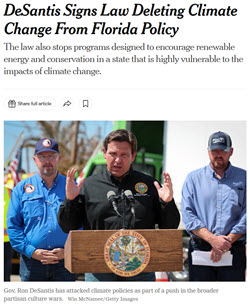
“The legislation I signed today [will] keep windmills off our beaches, gas in our tanks, and China out of our state." — Ron DeSantis, conflating geopolitics and consumer choices with anthropogenic climate change.
Thanks to it being about fake skepticism, our story of the week concerns Florida Governor Ron DeSantis and his efforts aided by the Florida state legislature to purge Florida's government of the entire concept of human-caused climate change and the inevitable public policy replies dictated by our clumsy, too-rapid disruption of Earth's more typical climate dithering. Coverage includes:
- DeSantis signs bill scrubbing ‘climate change’ from Florida law
- DeSantis Signs Law Deleting Climate Change From Florida Policy
- DeSantis says he`s `restoring sanity` by erasing climate change from Florida laws
Governor DeSantis joins a small cadre of other elite, empowered cranks who've walked broadly similar paths. Picking on the most notorious person previously afforded the opportunity to attempt conjuring reality out of existence at the highest levels of access, we may ask a question. Who leaves a more lasting impact on our planet by confusing political ideology with scientific knowledge, Joseph Stalin's protege Trofim Lysenko, or Ron DeSantis? The two share a flaw— dictating politically acceptable understanding of matters connected to science even when doing so requires science denial— but whose impact endures the longest?
By commingling political ideology with science, Lysenko caused acutely disastrous effects on agriculture in his country. However, Lysenko's drastic sway over the USSR's scientific community was fairly narrowly confined in both scope and time. After his ascent to prominence in the 1930s, Lysenko's star was rapidly fading a mere 30 years later. Mass starvation thanks to pseudoscientific practices and liquidations of "wrong-thinking" Mendelian geneticists quietly ended and now appear as relatively small features of the USSR's huge history. Lysenko's longest shadow ended up cast on scientific progress never realized thanks to his critics in academia having a tendency to end up dead or imprisoned.
Rather than erupting from the scientific establishment as with Lysenko, Governor DeSantis emerged from the world of law and he's also playing a role less directly and immediately lethal to residents of Florida and scientists practicing there. But to the extent that it is successful, DeSantis' legislative accomplishment is similar to Lysenko's. It prohibits fully truthful and useful discussion and acknowledgement of climate science in public policy. To ban the term "climate change" in law and policy is fundamentally a denial of the existence of useful scientific knowledge. As with Lysenko's preposterous but mandatory omissions of true and useful understanding of plant genetics in the former USSR, this will have powerful ripple effects.
From a local perspective, Florida is unusually threatened by multiple aspects of climate change. It's safe to say that any friction applied to Florida's governmental response to these challenges will come at cost to residents of Florida. For instance, the state is already facing a dire insurance problem in connection with intensifying precipitation and rising sea level. It's fair to ask how DeSantis' theatrical stance addresses this conundrum. It truthfully can't, because the legislation's entire point is to avoid and prohibit mentioning "climate change." Meanwhile banned wind turbines, the cost of gas at the pump roughly tracking inflation over the years and Chinese communists hiding beneath our beds have nothing to do with Florida's property insurance problems, which are all about climate change. Governor DeSantis' proudly-signed HB 1645 is what a reasonable person might describe as functionally useless legislation in terms of helping Floridians deal with burgeoning real-world climate problems.
We don't have the capacity to fully model the larger and longer effects of Florida's law attempting to deny the existence of some fairly basic physics. What we can say is that every procrastination over reducing our CO2 emissions will have a very long tail of effects and expense. The longer we delay modernizing our energy systems, the longer we'll see otherwise avoidable sea level rise, destructive meteorological effects, ecological failures— and needless suffering inflicted on people in Florida and far beyond. A single US state governor isn't determinative of the future of the planet, but much more than most of us such a person can exert more influence on our net outcome in dealing with the climate challenge we've created. By impeding Florida's climate mitigation public policy response, Governor DeSantis is casting a very long shadow on history— effects that with more perfect instrumentation we'd be able to measure— and seems to easily put Stalin's pet pseudoscientist Lysenko in the shade.
Stories we promoted this week, by publication date:
Before May 12
- Global weather crisis: From Brazil to Houston and Asia, extreme weather grips the Globe, Africanews, Rédaction Africanews with AP. "In Brazil, floods have killed dozens of people and destabilised a city of around 4 million people. In India, at the time of national elections, voters and politicians fainted in heat that reached 46.3 degrees Celsius (115.3 degrees Fahrenheit)."
- Michael Mann: "Defeatism is as much of a threat as climate denial", New Statesman, Megan Kenyon. The renowned climatologist on net zero and the fight for democracy.
- Reparation for Climate Change at the ECtHR, Climate Law Blog, Armando Rocha, Maria Antonia Tigre, Vladislava Stoyanova, Eneas Xavier, Camille Martini and Miriam Cohen. A Missed Opportunity or the First of Many Decisions to Come?
- The world is obsessed with forests` climate benefits. Here`s the problem., Grist, Kate Yoder. People depend on forests for food and income. Offset projects can kick them out.
- As Extreme Weather Batters Schools, Students Are Pushing For More Climate Change Education, Today's Climate, Inside Climate News, Kiley Price. "Though climate change education varies across public schools in the U.S., extreme weather impacts are affecting them all".
- Climate Extremes Slammed Latin America and the Caribbean Last Year. A New UN Report Details the Impacts and Costs, Science, Inside Climate News, Bob Berwyn. "Some scientists in the region said many of the effects seen today weren’t expected until the second half of the century."
- ‘I am starting to panic about my child’s future’: climate scientists wary of starting families, Environment, The Guardian, Damian Carrington. "A fifth of female climate scientists who responded to Guardian survey said they had opted to have no or fewer children"
- Climate scientists have told the Guardian they expect catastrophic levels of global heating. Here’s what that would mean for the planet, Explainer, Environment, The Guardian, Damian Carrington. "Climate scientists have told the Guardian they expect catastrophic levels of global heating. Here’s what that would mean for the planet"
- How to talk about climate change – and what motivates people to action An interview with Katharine Hayhoe, Eset, Tomáš Foltýn. We spoke to climate scientist Katharine Hayhoe about climate change, faith and psychology – and how to channel anxiety about the state of our planet into meaningful action
Fact Brief - Does breathing contribute to CO2 buildup in the atmosphere?
Posted on 18 May 2024 by SkS-Team
![]() Skeptical Science is partnering with Gigafact to produce fact briefs — bite-sized fact checks of trending claims. This fact brief was written by Sue Bin Park in collaboration with members from our Skeptical Science team. You can submit claims you think need checking via the tipline.
Skeptical Science is partnering with Gigafact to produce fact briefs — bite-sized fact checks of trending claims. This fact brief was written by Sue Bin Park in collaboration with members from our Skeptical Science team. You can submit claims you think need checking via the tipline.
Does breathing contribute to CO2 buildup in the atmosphere?
 The CO2 we breathe is part of a balanced carbon exchange between the air and the earth. In contrast, burning fossil fuels injects CO2 into the atmosphere that has been stored underground for millions of years, causing a rapid buildup.
The CO2 we breathe is part of a balanced carbon exchange between the air and the earth. In contrast, burning fossil fuels injects CO2 into the atmosphere that has been stored underground for millions of years, causing a rapid buildup.
Fast cycling of carbon is seasonal. CO2 increases in colder months when plants decay and release their carbon. In the warmer months, CO2 decreases as plants take it in, along with sunlight, to produce energy and oxygen. Animals — including humans — eat plants, breathe in oxygen, and exhale CO2. Graphs of CO2 show a wave pattern reflecting this seasonal change.
Fossil fuels are part of the slow carbon cycle that operates over geological timescales. Burning fossil fuels takes carbon stored in the slow cycle and introduces it into the fast one. This activity is unique in Earth’s history; no other life-form has done anything on the same scale.
Go to full rebuttal on Skeptical Science or to the fact brief on Gigafact
This fact brief is responsive to conversations such as this one.
Sources
MIT Climate Portal Does the carbon dioxide that humans breathe out contribute to climate change?
US San Diego The Keeling Curve
McGill University Office for Science and Society Why isn't the carbon dioxide from breathing a concern for global warming?































 Arguments
Arguments
























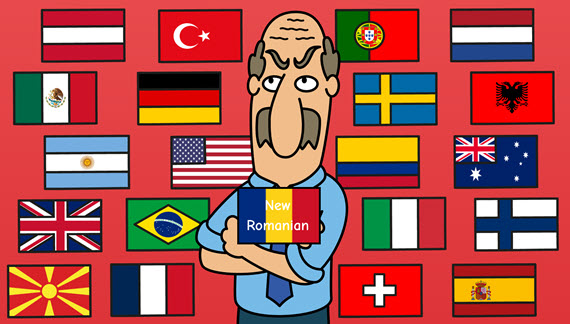
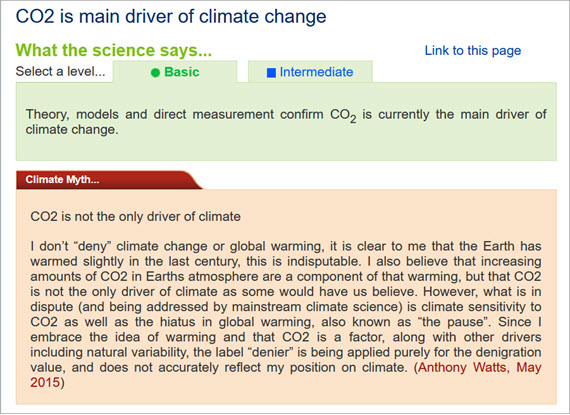
 (Background photo credit: NASA/NOAA GOES Project /
(Background photo credit: NASA/NOAA GOES Project / 